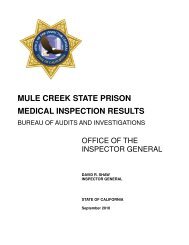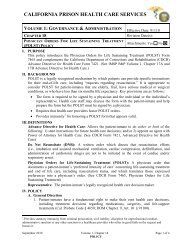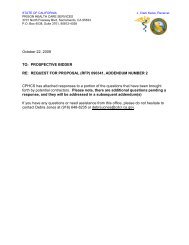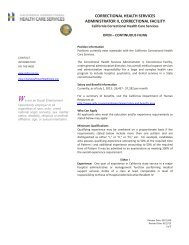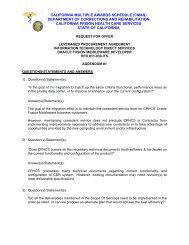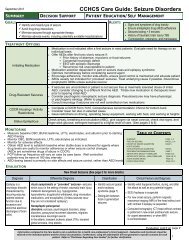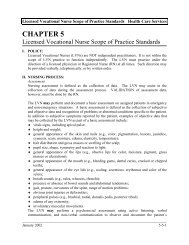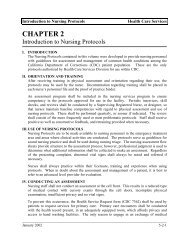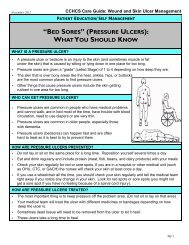california state prison, sacramento medical inspection results
california state prison, sacramento medical inspection results
california state prison, sacramento medical inspection results
Create successful ePaper yourself
Turn your PDF publications into a flip-book with our unique Google optimized e-Paper software.
CALIFORNIA STATE PRISON,SACRAMENTOMEDICAL INSPECTION RESULTSBUREAU OF AUDITS AND INVESTIGATIONSOFFICE OF THEINSPECTOR GENERALDAVID R. SHAWINSPECTOR GENERALSTATE OF CALIFORNIANOVEMBER 2008
ContentsExecutive Summary ................................................................................. 1Introduction .............................................................................................. 3Background ................................................................................... 3About the Institution ..................................................................... 4Objectives, Scope, and Methodology.......................................... 4Medical Inspection Results ..................................................................... 7California Prison Health Care ReceivershipCorporation’s Response............................................................. 24Office of the Inspector General’s Comments onthe Receiver’s Response ............................................................ 26
Executive SummaryAn April 2001 class action lawsuit filed by inmates represented by the Prison Law Office allegedthat the <strong>state</strong> provided constitutionally inadequate <strong>medical</strong> care at California <strong>state</strong> <strong>prison</strong>s inviolation of inmates’ constitutional rights. And, in October 2005, the U.S. Northern DistrictCourt of California declared that California’s delivery system for <strong>prison</strong> <strong>medical</strong> care was“broken beyond repair” and still not meeting constitutional standards. As a result, the federalcourt imposed a receivership to raise the delivery of <strong>medical</strong> care to constitutional standards. Toevaluate and monitor the progress of <strong>medical</strong> care delivery to inmates, the receiver requested,and the Office of the Inspector General (OIG) agreed, to establish an objective, clinicallyappropriate, and metric-oriented <strong>medical</strong> program to annually inspect the delivery of <strong>medical</strong>care at each <strong>state</strong> <strong>prison</strong>.OverallScore65.2%In September 2008, we inspected California State Prison, Sacramento (CSPSacramento). Our <strong>medical</strong> <strong>inspection</strong> encompassed 20 components of <strong>medical</strong>delivery and comprised 145 questions. The questions are weighted based ontheir importance to the delivery of <strong>medical</strong> care to inmates. CSP Sacramentoreceived 65.2 percent of the total weighted points possible.The following summary table lists the 20 components we inspected in order of importance(highest to lowest), with the institution’s score and the definitions of each <strong>inspection</strong> component.The detailed <strong>medical</strong> <strong>inspection</strong> <strong>results</strong>, with the questions for each component, begin on page 7of this report. While we are committed to helping each institution achieve a higher level of<strong>medical</strong> care, it is not our intent to determine the percentage score needed by an institution tomeet constitutional standards—that is a legal matter for the federal court to determine.Executive Summary TableComponentWeightedScoreDefinitionChronic Care 62.7% Examines how well the <strong>prison</strong> provided care and medication to inmates withspecific chronic care conditions, which are those that affect (or have thepotential to affect) an inmate’s functioning and long-term prognosis formore than six months. Our <strong>inspection</strong> tests the following chronic careconditions: asthma, Coumadin therapy, diabetes, HIV (HumanImmunodeficiency Virus), and hypertension.Clinical Services 67.0% Evaluates the inmate’s access to primary health care services and focuses oninmates who recently received services from any of the <strong>prison</strong>’s facility oradministrative segregation unit clinics. This component evaluates sick callprocesses (doctor or nurse line), medication management, and nursing.Health Screening 76.4% Focuses on the <strong>prison</strong>’s process for screening new inmates upon arrival tothe institution for health care conditions that require treatment andmonitoring, as well as ensuring inmates’ continuity of care.Specialty Services 47.4% Focuses on the <strong>prison</strong>’s process for approving, denying, and schedulingservices that are outside the specialties of the <strong>prison</strong>’s <strong>medical</strong> staff.Common examples of these services include physical therapy, oncologyservices, podiatry consultations, and neurology services.Urgent Services 82.5% Addresses the care provided by the institution to inmates before and afterthey were sent to a community hospital.Bureau of Audits and Investigations Page 1Office of the Inspector GeneralState of California
ComponentWeightedScoreDefinitionEmergency Services 47.5% Examines how well the <strong>prison</strong> responded to <strong>medical</strong> emergencies.Specifically, we focused on “man down” or “woman down” situations.Further, questions determine the adequacy of <strong>medical</strong> and staff response to a“man down” or “woman down” emergency drill.Prenatal Care/Childbirth/PostdeliveryN/A Focuses on the prenatal and post-delivery <strong>medical</strong> care provided to pregnantinmates. Not applicable at men’s institutions.Diagnostic Services 68.1% Addresses the timeliness of radiology (x-ray) and laboratory services andwhether the <strong>prison</strong> followed up on clinically significant <strong>results</strong>.Access to Health Care Information 39.2% Addresses the <strong>prison</strong>’s effectiveness in filing, storing, and retrieving <strong>medical</strong>records and <strong>medical</strong>-related information.Outpatient Housing Unit 75.6% Determines whether the <strong>prison</strong> followed department policies and procedureswhen placing inmates in the outpatient housing unit. This component alsoevaluates whether the placement provided the inmate with adequate care andwhether the physician’s plan addressed the placement diagnosis.Internal Reviews 70.4% Focuses on the frequency of meetings held by the <strong>prison</strong>’s QualityManagement Committee (QMC) and Emergency Response ReviewCommittee (ERRC) and whether key staff attended the meetings, thenumber of <strong>medical</strong> appeals filed, and the <strong>prison</strong>’s death review process.Inmate Transfers 75.3% Focuses on inmates pending transfer to determine whether the sendinginstitution documented medication and <strong>medical</strong> conditions to assist thereceiving institution in providing continuity of care.Clinic Operations 91.0% Addresses the general operational aspects of the <strong>prison</strong>’s facility clinics.Generally, the questions in this component relate to the overall cleanlinessof the clinics, privacy afforded to inmates during nonemergency visits, useof priority ducats (slip of paper the inmate carries for scheduled <strong>medical</strong>appointments), and availability of health care request forms.Preventive Services 32.1% Focuses on inmate cancer screening and influenza immunizations.Pharmacy Services 74.5% Addresses whether the <strong>prison</strong>’s pharmacy complies with various operationalpolicies, such as conducting periodic inventory counts and maintaining thecurrency of medications in its night lockers, keeping signature cards on filefor doctors, and having valid permits. In addition, this component alsoaddresses whether the pharmacy has an effective process for screeningmedication orders for potential adverse reactions/interactions.Other Services 90.6% Examines additional areas that are not captured in the other components.The areas evaluated in this component include the <strong>prison</strong>’s provision oftherapeutic diets, its handling of inmates who display poor hygiene, and theavailability of the current version of the department’s Health ServicesPolicies and Procedures.Inmate Hunger Strikes 10.5% Examines <strong>medical</strong> staff’s monitoring of inmates participating in hungerstrikes.Chemical Agent Contraindications 100% Addresses the <strong>prison</strong>’s process of handling inmates who may be predisposedto an adverse outcome from calculated uses of force (cell extractions)involving Oleoresin Capsicum (OC), which is commonly referred to as“pepper spray.” For example, this might occur if the inmate has asthma.Staffing Levels and Training 95.0% Examines the <strong>prison</strong>’s <strong>medical</strong> staffing levels and training provided.Nursing Policy 78.6% Determines whether the <strong>prison</strong> maintains written policies and procedures forthe safe and effective provision of quality nursing care. The questions in thiscomponent also determine whether nursing staff review their duty<strong>state</strong>ments and whether supervisors periodically review the work of nursesto ensure they properly follow established nursing protocols.Overall Score 65.2%Bureau of Audits and Investigations Page 2Office of the Inspector GeneralState of California
IntroductionUnder the authority of California Penal Code section 6126, which assigns the Office of theInspector General (OIG) responsibility for oversight of the California Department of Correctionsand Rehabilitation, and at the request of the federal receiver, the OIG developed acomprehensive <strong>inspection</strong> program to evaluate the delivery of <strong>medical</strong> care at each of theCalifornia Department of Corrections and Rehabilitation’s 33 adult <strong>prison</strong>s.In September 2008, we inspected California State Prison, Sacramento (CSP Sacramento). Our<strong>medical</strong> <strong>inspection</strong> encompassed 20 components of <strong>medical</strong> delivery and comprised 145questions. To help readers understand the <strong>medical</strong> risk associated with certain components of<strong>medical</strong> delivery—which pose a greater risk to an inmate-patient—we developed a weightingsystem and assigned points to each question. Consequently, we assigned more total points tomore critical components, such as chronic care, clinical services, and health screening. Weassigned fewer total points to less critical components, such as inmate hunger strikes, staffinglevels and training, and chemical agent contraindications. (For a detailed description of theweighting system, see Objectives, Scope, and Methodology on the next page.)BackgroundIn April 2001, inmates represented by the Prison Law Office filed a class action lawsuit, nowknown as Plata v. Schwarzenegger. The lawsuit alleged that the <strong>state</strong> provided constitutionallyinadequate <strong>medical</strong> care at California <strong>state</strong> <strong>prison</strong>s in violation of inmates’ constitutional rights.In June 2002, the parties entered into a Stipulation for Injunctive Relief, and the <strong>state</strong> agreed toimplement over several years comprehensive new <strong>medical</strong> care policies and procedures at allinstitutions.Nevertheless, the U.S. Northern District Court of California declared in October 2005 thatCalifornia’s delivery system for <strong>prison</strong> <strong>medical</strong> care was “broken beyond repair” and still notmeeting constitutional standards. Thus, the federal court imposed a receivership to raise thedelivery of <strong>medical</strong> care to constitutional standards. In essence, the court ordered the receiver tomanage the <strong>state</strong>’s delivery of <strong>medical</strong> care and restructure day-to-day operations to develop andsustain a system that provides constitutionally adequate <strong>medical</strong> care to inmates. The court <strong>state</strong>dthat it would remove the receiver and return control to the <strong>state</strong> once the system is stable andprovides for constitutionally adequate <strong>medical</strong> care.To evaluate and monitor the progress of <strong>medical</strong> care delivery to inmates, the receiver requestedthat the OIG establish an objective, clinically appropriate, and metric-oriented <strong>medical</strong><strong>inspection</strong> program. Toward that end, the Inspector General agreed to inspect annually each <strong>state</strong><strong>prison</strong> until the <strong>state</strong>’s delivery of <strong>medical</strong> care to inmates meets constitutional standards. We arecommitted to helping each institution achieve a higher level of <strong>medical</strong> care, but it is up to thefederal court to determine the percentage score necessary for an institution to meet constitutionalstandards.Bureau of Audits and Investigations Page 3Office of the Inspector GeneralState of California
About the InstitutionCSP Sacramento, which opened in 1986, is located adjacent to Folsom State Prison. When it firstopened in 1986, the institution was administered by the warden of Folsom State Prison andcalled New Folsom. In 1992, the institution’s name was changed to California State Prison,Sacramento, and since then has been administered as a separate <strong>prison</strong> with its own warden.CSP Sacramento houses maximum security inmates serving long sentences or inmates that havebeen management problems at other institutions. The institution also serves as a <strong>medical</strong> hub forNorthern California with a psychiatric services unit, an enhanced outpatient program, and anenhanced outpatient administrative segregation unit. Along with several clinics that handle nonurgentrequests for <strong>medical</strong> services, CSP Sacramento treats inmates needing urgent oremergency care in its three triage and treatment areas (TTA). Further, the institution has anoutpatient housing unit and a <strong>state</strong>-licensed correctional treatment center. As ofSeptember 17, 2008, the California Department of Corrections and Rehabilitation reported thatCSP Sacramento housed 3,026 male inmates.Jasdeep Bal, M.D., who serves as both the institution’s health care manager and chief <strong>medical</strong>officer, is responsible for CSP Sacramento’s entire health care program.Objectives, Scope, and MethodologyIn designing the <strong>medical</strong> <strong>inspection</strong> program, we reviewed the California Department ofCorrections and Rehabilitation’s policies and procedures, relevant court orders, guidelinesdeveloped by the department’s Quality Medical Assurance Team, and guidance developed by theAmerican Correctional Association. We also reviewed professional literature on correctional<strong>medical</strong> care, consulted with clinical experts, and met with stakeholders from the court, thereceiver’s office, the department, and the Prison Law Office to discuss the nature and scope ofthe <strong>inspection</strong> program. Based on input from these stakeholders, we developed a <strong>medical</strong><strong>inspection</strong> program that evaluates <strong>medical</strong> care delivery. Within each of 20 components, wecreated “yes” or “no” questions designed to gauge performance.To make the <strong>inspection</strong> <strong>results</strong> meaningful to both a <strong>medical</strong> expert and a lay reader, we workedwith clinical experts to create a weighting system that factors the relative importance of eachcomponent compared to other components. Further, the program considers the relativeimportance of each question within a component to the other questions in that component. Thisweighting ensures that more critical components—such as those that pose the greatest <strong>medical</strong>risk to the inmate-patient—are given more weight compared to those considered less serious. Forexample, we assign a high number of possible points to the chronic care component because weconsider this the most serious of all the components. Conversely, we assign very few points tothe nursing policy component because we consider this the least serious <strong>inspection</strong> component.Each <strong>inspection</strong> question is weighted and scored. The score is derived from the percentage of“yes” answers for each question from all items sampled. We then multiply the percentage of“yes” answers within a given question by the question’s weight to arrive at a score. Thefollowing example shows how this scoring system works.Bureau of Audits and Investigations Page 4Office of the Inspector GeneralState of California
Example Question: Institution XAnswers Weighting Points N/A UnkYes No Yes + No Yes % Possible ReceivedIs the clinical history adequate? 40 10 50 80% 20 16 0 0If the institution receives 40 “yes” answers and 10 “no” answers, the percentage of “yes”answers to this question equals 80 percent. We calculate the number of points the institutionwould receive by multiplying the “yes” percent of 80 by the number of possible points for thisquestion, which is 20, to arrive at 16 points.To arrive at the total score, we add the points received for each question and then for eachprogram component. Finally, we calculate the institution’s overall score by dividing the sum ofthe points received by the sum of the points possible. We do not include in the institution’soverall score the weight for questions that are not applicable or, in some cases, where a lack ofdocumentation would result in numerous “no” answers for one deviation from policy (unknown).For instance, an institution may not be able to provide documentation that its emergencyresponse review committee met for a particular month. Therefore, when we evaluate whethermeeting minutes document monthly meetings for a particular month, the institution wouldreceive a “no” answer for that question. However, when we evaluate whether the meetingminutes document the warden’s attendance at the meeting, the answer would be “unknown” sothat the institution’s score is not penalized twice for the same reason, not documenting themeeting.To evaluate the institution’s delivery of <strong>medical</strong> care, we obtained various electronic data filesmaintained by the institution for inmate <strong>medical</strong> scheduling and tracking, pharmacy, and censusdata. We used these electronic data files only to identify random samples of inmates receiving orrequiring specific <strong>medical</strong> services. We then reviewed the <strong>medical</strong> file for each inmate in oursample. We did not rely on the <strong>medical</strong> care information contained in these data files.In total, we reviewed 175 inmate <strong>medical</strong> files, which are referred to as unit health records. Inaddition, we reviewed staffing level reports, <strong>medical</strong> appeals summaries, nursing protocols,summaries of <strong>medical</strong> drills and emergencies, minutes from Quality Management Committeeand Emergency Response Review Committee hearings, and assorted manual logs or trackingworksheets related to <strong>medical</strong> care delivery. We also conducted a live <strong>medical</strong> emergency drilland evaluated the adequacy of the responding staff’s actions. Finally, we interviewed <strong>medical</strong>and custody staff members about the delivery of <strong>medical</strong> care to inmates, and we observed dayto-day<strong>medical</strong> delivery at the institution.We do not test the care provided in the licensed hospitals or correctional treatment centersbecause they are subject to <strong>inspection</strong>s and oversight by other regulatory agencies.Consistent with our agreement with the receiver, our report only addresses the conditions foundrelated to the <strong>medical</strong> care criteria. We do not discuss the causes of noncompliance, nor do wemake specific recommendations in this report. However, if we learn of an inmate-patient whoneeds immediate care, we notify the chief <strong>medical</strong> officer and request a status report. Moreover,if we learn of significant departures from community standards, we may report such departuresto the institution’s chief <strong>medical</strong> officer or quality management committee. Because theseBureau of Audits and Investigations Page 5Office of the Inspector GeneralState of California
matters involve confidential <strong>medical</strong> information protected by <strong>state</strong> and federal privacy laws,specific details related to these cases are not included in our report.For ease of reference, following is a table of abbreviations used in the remainder of this report.Abbreviations used in this reportAED Automatic External DefibrillatorBLS Basic Life SupportCDCR California Department of Corrections and RehabilitationCMO Chief Medical OfficerCPR Cardio-Pulmonary ResuscitationCTC Correctional Treatment CenterCTQ Confined to QuartersER Emergency RoomERRC Emergency Response Review CommitteeFOBT Fecal Occult Blood TestFTF Face-to-FaceGACH General Acute Care HospitalHCM Health Care ManagerHIV Human Immunodeficiency VirusINH Isoniazid (antituberculous medication)LVN Licensed Vocational NurseMD Medical DoctorMOD Medical Officer of the DayOB ObstetricianOC Oleoresin Capsicum (pepper spray)OHU Outpatient Housing UnitOIG Office of the Inspector GeneralPCP Primary Care ProviderQMC Quality Management CommitteeRN Registered NurseSOAPE Subjective, Objective, Assessment, Plan, EducationSRN Supervising Registered NurseTB TuberculosisTTA Triage and Treatment AreaUHR Unit Health RecordUM Utilization ManagementBureau of Audits and Investigations Page 6Office of the Inspector GeneralState of California
OFFICE OF THE INSPECTOR GENERALCALIFORNIA STATE PRISON, SACRAMENTOMEDICAL INSPECTION RESULTS9/22/2008 - 9/25/2008Overall Score:65.2%Answers Weighting Points Questions Not AnsweredComponent Page Yes No Yes + No Yes % Points Possible Points Received Score % Not Applicable UnknownChronic Care 8 121 77 198 61.1% 133 83.4 62.7% 4 3Clinical Services 8 210 61 271 77.5% 95 63.6 67.0% 51 0Health Screening 10 78 17 95 82.1% 59 45.1 76.4% 80 5Specialty Services 11 38 51 89 42.7% 71 33.7 47.4% 28 2Urgent Services 12 82 23 105 78.1% 59 48.7 82.5% 49 6Emergency Services 13 20 18 38 52.6% 59 28.0 47.5% 2 3Diagnostic Services 14 38 17 55 69.1% 52 35.4 68.1% 10 0Access to Health Care Information 15 4 4 8 50.0% 51 20.0 39.2% 0 0Outpatient Housing Unit 16 62 20 82 75.6% 48 36.3 75.6% 2 2Internal Reviews 17 29 4 33 87.9% 40 28.2 70.4% 0 1Inmate Transfers 18 15 6 21 71.4% 38 28.6 75.3% 4 0Clinic Operations 18 26 3 29 89.7% 29 26.4 91.0% 1 0Preventive Services 19 9 16 25 36.0% 24 7.7 32.1% 1 0Pharmacy Services 20 9 8 17 52.9% 29 21.6 74.5% 0 0Other Services 21 8 1 9 88.9% 16 14.5 90.6% 1 0Inmate Hunger Strikes 21 1 8 9 11.1% 19 2.0 10.5% 0 0Chemical Agent Contraindications 21 15 0 15 100.0% 17 17.0 100.0% 5 0Staffing Levels and Training 22 7 1 8 87.5% 16 15.2 95.0% 1 0Nursing Policy 23 12 3 15 80.0% 14 11.0 78.6% 0 0Totals 784 338 1122 69.9% 869 566.3 65.2%239 22Bureau of Audits and InvestigationsOffice of the Inspector GeneralPage 7State of California
ReferenceNumberAnswersWeighting PointsChronic Care Yes No Yes + No Yes % Possible Received Score % N/A Unk03.076 Was the inmate's most recent chronic care visit within the time framerequired by the degree of control of the inmate's condition based onhis or her prior visit?22 3 25 88.0% 10 8.8 88.0% 0 003.077 Were key elements on Forms 7419 (Chronic Care Follow-Up Visit)and 7392 (Primary Care Flow Sheet) filled out completely for theinmate's two most recent visits?03.082 Did the institution document that it provided the inmate with healthcare education?03.175 Did the inmate receive his or her prescribed chronic care medicationsduring the most recent three-month period or did the institutionfollow departmental policy if the inmate refused to pick up or showup for his or her medications?1 24 25 4.0% 10 0.4 4.0% 0 016 9 25 64.0% 12 7.7 64.0% 0 011 13 24 45.8% 18 8.3 45.8% 0 103.235 Is the clinical history adequate? 12 8 20 60.0% 18 10.8 60.0% 0 003.236 Is the focused clinical examination adequate? 17 3 20 85.0% 19 16.2 85.0% 0 003.237 Is the assessment adequate? 11 4 15 73.3% 19 13.9 73.3% 4 103.238 Is the plan adequate and consistent with the degree of control basedon the chronic care program intervention and follow up requirements?03.262 Is the inmate's Problem List complete and filed accurately in theinmate's unit health record (UHR)?Component Subtotals:11 8 19 57.9% 19 11.0 57.9% 0 120 5 25 80.0% 8 6.4 80.0% 0 0121 77 198 61.1% 133 83.4 62.7% 4 3ReferenceNumberAnswersWeighting PointsClinical Services Yes No Yes + No Yes % Possible Received Score % N/A Unk01.024 RN FTF Documentation: Did the inmate's request for health care getreviewed the same day it was received?24 1 25 96.0% 4 3.8 96.0% 0 0Bureau of Audits and InvestigationsOffice of the Inspector GeneralPage 8State of California
ReferenceNumberAnswersWeighting PointsClinical Services Yes No Yes + No Yes % Possible Received Score % N/A Unk01.027 If the RN determined a referral to a primary care physician (PCP)was necessary, was the inmate seen within the timelines specified bythe RN during the FTF triage?5 12 17 29.4% 8 2.4 29.4% 8 001.247 Sick Call Follow-up: If the provider ordered a follow-up sick callappointment, did it take place within the time frame specified?01.124 Sick Call Medication: Did the institution administer or deliverprescription medications (new orders) to the inmate within specifiedtime frames?01.025 RN FTF Documentation: Did the RN complete the face-to-face(FTF) triage within one (1) business day after the Form 7362 wasreviewed?01.246 Did documentation indicate that the RN reviewed all of the inmate'scomplaints listed on Form 7362 (Health Care Services RequestForm)?01.157 RN FTF Documentation: Did the RN's subjective note address thenature and history of the inmates primary complaint?01.159 RN FTF Documentation: Did the RN's objective note include vitalsigns and a focused physical examination, and did it adequatelyaddress the problems noted in the subjective note?01.244 RN FTF Documentation: Did the RN's objective note includeallergies, weight, current medication, and where appropriate,medication compliance?01.158 RN FTF Documentation: Did the RN's assessment provideconclusions based on subjective and objective data, were theconclusions formulated as patient problems, and did it containapplicable nursing diagnoses?01.162 RN FTF Documentation: Did the RN's plan include an adequatestrategy to address the problems identified during the FTF triage?1 3 4 25.0% 7 1.8 25.0% 21 05 18 23 21.7% 6 1.3 21.7% 2 019 6 25 76.0% 6 4.6 76.0% 0 023 2 25 92.0% 5 4.6 92.0% 0 022 2 24 91.7% 7 6.4 91.7% 1 021 2 23 91.3% 6 5.5 91.3% 2 022 2 24 91.7% 3 2.8 91.7% 1 021 1 22 95.5% 6 5.7 95.5% 3 022 2 24 91.7% 7 6.4 91.7% 1 0Bureau of Audits and InvestigationsOffice of the Inspector GeneralPage 9State of California
ReferenceNumberAnswersWeighting PointsClinical Services Yes No Yes + No Yes % Possible Received Score % N/A Unk01.163 RN FTF Documentation: Did the RN's education/instructionadequately address the problems identified during the FTF triage?17 5 22 77.3% 5 3.9 77.3% 3 015.234 Are clinic response bags audited daily and do they contain essentialitems?21.278 Was there adequate prior management of pre-existing <strong>medical</strong>conditions that contributed to the need for the TTA visit?Component Subtotals:0 2 2 0.0% 5 0.0 0.0% 0 08 3 11 72.7% 20 14.5 72.7% 9 0210 61 271 77.5% 95 63.6 67.0% 51 0ReferenceNumberAnswersWeighting PointsHealth Screening Yes No Yes + No Yes % Possible Received Score % N/A Unk02.016 Did the institution complete the initial health screening on the sameday the inmate arrived at the institution?20 0 20 100.0% 9 9.0 100.0% 0 002.020 Did the LVN/RN adequately document the tuberculin test or a reviewof signs and symptoms if the inmate had a previous positivetuberculin test?02.015 Was a review of symptoms completed if the inmate's tuberculin testwas positive, and were the <strong>results</strong> reviewed by the infection controlnurse?02.128 If the inmate had an existing medication order upon arrival at theinstitution, did the inmate receive the medications by the nextcalendar day, or did a physician explain why the medications werenot to be continued?02.007 Non-reception center: Does the health care transfer information formindicate that it was reviewed and signed by licensed health care staffwithin one calendar day of the inmate's arrival at the institution?02.014 Non-reception center: If the inmate was scheduled for a specialtyappointment at the sending institution, did the receiving institutionschedule the appointment within 30 days of the original appointmentdate?18 2 20 90.0% 6 5.4 90.0% 0 01 0 1 100.0% 7 7.0 100.0% 17 24 8 12 33.3% 8 2.7 33.3% 8 019 0 19 100.0% 7 7.0 100.0% 0 10 0 0 0.0% 0 0.0 0.0% 19 1Bureau of Audits and InvestigationsOffice of the Inspector GeneralPage 10State of California
ReferenceNumberAnswersWeighting PointsHealth Screening Yes No Yes + No Yes % Possible Received Score % N/A Unk02.111 Non-reception center: Did the inmate receive <strong>medical</strong>accommodations upon arrival, if applicable?2 1 3 66.7% 6 4.0 66.7% 16 102.017 If yes was answered to any of the questions on the initial healthscreening form(s), did the RN provide an assessment and dispositionon the date of arrival?02.018 If, during the assessment, the RN referred the inmate to a clinician,was the inmate seen within the time frame?Component Subtotals:12 0 12 100.0% 8 8.0 100.0% 8 02 6 8 25.0% 8 2.0 25.0% 12 078 17 95 82.1% 59 45.1 76.4% 80 5ReferenceNumberAnswersWeighting PointsSpecialty Services Yes No Yes + No Yes % Possible Received Score % N/A Unk07.037 Did the institution approve or deny the PCP's request for specialtyservices within the specified time frames?10 12 22 45.5% 8 3.6 45.5% 0 007.038 Did the PCP see the inmate between the date the PCP ordered theservice and the date the inmate received it, in accordance withspecified time frames?07.035 Did the inmate receive the specialty service within specified timeframes?07.090 Physical therapy services: Did the physical therapist assess theinmate and document the treatment plan and treatment provided tothe inmate?07.043 Did the PCP review the consultant's report and see the inmate for afollow-up appointment after the specialty services consultation withinspecified time frames?07.260 Was the institution's denial of the PCP's request for specialty servicesconsistent with the "<strong>medical</strong> necessity" requirement?07.259 Was there adequate documentation of the reason for the denial ofspecialty services?1 12 13 7.7% 8 0.6 7.7% 4 08 9 17 47.1% 9 4.2 47.1% 0 02 0 2 100.0% 8 8.0 100.0% 15 02 7 9 22.2% 9 2.0 22.2% 7 14 0 4 100.0% 9 9.0 100.0% 0 13 2 5 60.0% 5 3.0 60.0% 0 0Bureau of Audits and InvestigationsOffice of the Inspector GeneralPage 11State of California
ReferenceNumberAnswersWeighting PointsSpecialty Services Yes No Yes + No Yes % Possible Received Score % N/A Unk07.270 Did the specialty provider provide timely findings andrecommendations or did an RN document that he or she called thespecialty provider to ascertain the findings and recommendations?8 7 15 53.3% 6 3.2 53.3% 2 007.261 Is the institution scheduling high-priority (urgent) specialty serviceswithin 14 days?Component Subtotals:0 2 2 0.0% 9 0.0 0.0% 0 038 51 89 42.7% 71 33.7 47.4% 28 2ReferenceNumberAnswersWeighting PointsUrgent Services Yes No Yes + No Yes % Possible Received Score % N/A Unk21.248 Upon the inmate's discharge from the community hospital, did thetriage and treatment area (TTA) registered nurse document that he orshe reviewed the inmate's discharge plan and completed a face-tofaceassessment of the inmate?15 4 19 78.9% 7 5.5 78.9% 1 021.250 Upon the inmate's discharge from the community hospital, did theinmate's Primary Care Provider (PCP) provide orders for appropriatehousing for the inmate?21.251 Upon the inmate's discharge from the community hospital, did theregistered nurse intervene if the inmate was housed in an area thatwas inappropriate for nursing care based on the primary careprovider's (PCP) housing orders?21.249 Upon the inmate's discharge from the community hospital, did theinmate receive a follow-up appointment with his or her primary careprovider (PCP) within five calendar days of discharge?21.281 Upon the inmate's discharge from a community hospital, did theinstitution administer or deliver all prescribed medications to theinmate within specified time frames?21.275 Was the TTA documentation adequate for evaluating the clinical careprovided?21.276 While the patient was in the TTA, was the clinical care rendered bythe attending provider adequate and timely?8 3 11 72.7% 7 5.1 72.7% 9 04 0 4 100.0% 7 7.0 100.0% 15 112 8 20 60.0% 7 4.2 60.0% 0 011 0 11 100.0% 6 6.0 100.0% 6 313 7 20 65.0% 10 6.5 65.0% 0 010 1 11 90.9% 7 6.4 90.9% 8 1Bureau of Audits and InvestigationsOffice of the Inspector GeneralPage 12State of California
ReferenceNumberAnswersWeighting PointsUrgent Services Yes No Yes + No Yes % Possible Received Score % N/A Unk21.279 For patients managed by telephone consultation alone, was theprovider's decision not to come to the TTA appropriate?9 0 9 100.0% 8 8.0 100.0% 10 1Component Subtotals:82 23 105 78.1% 59 48.7 82.5% 49 6ReferenceNumberAnswersWeighting PointsEmergency Services Yes No Yes + No Yes % Possible Received Score % N/A Unk08.183 Was the <strong>medical</strong> emergency responder notified of the <strong>medical</strong>emergency without delay?4 0 4 100.0% 5 5.0 100.0% 0 008.241 Did the first responder provide adequate basic life support (BLS)prior to <strong>medical</strong> staff arriving?08.184 Did the <strong>medical</strong> emergency responder arrive at the location of the<strong>medical</strong> emergency within five (5) minutes of initial notification?08.185 Did the <strong>medical</strong> emergency responder use proper equipment toaddress the emergency and was adequate <strong>medical</strong> care providedwithin the scope of his or her license?08.242 Did licensed health care staff call 911 without unnecessary delayafter a life-threatening condition was identified by a licensed healthcare provider or peace officer?08.187 Did the institution provide adequate preparation for the ambulance'sarrival, access to the inmate, and departure?08.186 Were both the first responder (if peace officer or licensed health carestaff) and the <strong>medical</strong> emergency responder basic life support (BLS)certified at the time of the incident?08.222 Were the findings of the institution's Emergency Response ReviewCommittee (ERRC) supported by the documentation and completedwithin 30 days?15.256 Emergency Medical Response Drill: Did the responding officerproperly perform an assessment on the patient for responsiveness?0 3 3 0.0% 6 0.0 0.0% 1 04 0 4 100.0% 4 4.0 100.0% 0 01 1 2 50.0% 7 3.5 50.0% 1 12 2 4 50.0% 6 3.0 50.0% 0 01 1 2 50.0% 4 2.0 50.0% 0 24 0 4 100.0% 4 4.0 100.0% 0 02 2 4 50.0% 7 3.5 50.0% 0 00 1 1 0.0% 1 0.0 0.0% 0 0Bureau of Audits and InvestigationsOffice of the Inspector GeneralPage 13State of California
ReferenceNumberAnswersWeighting PointsEmergency Services Yes No Yes + No Yes % Possible Received Score % N/A Unk15.257 Emergency Medical Response Drill: Did the responding officerproperly perform CPR?0 1 1 0.0% 2 0.0 0.0% 0 015.258 Emergency Medical Response Drill: Did the responding officerbegin CPR without unecessary delay?15.282 Emergency Medical Response Drill: Did <strong>medical</strong> staff arrive onscene in five minutes or less?15.283 Emergency Medical Response Drill: Did the emergency <strong>medical</strong>responders arrive with proper equipment (ER bag, bag-valve-mask,AED)?15.284 Emergency Medical Response Drill: Did the responding officerprovide accurate information to responding <strong>medical</strong> staff?15.285 Emergency Medical Response Drill: Did emergency <strong>medical</strong>responders continue basic life support?15.286 Emergency Medical Response Drill: Did <strong>medical</strong> staff continue withCPR without transporting the patient until the arrival of ambulancepersonnel? If the patient was transported, was this decision justified?15.287 Emergency Medical Response Drill: Was 911 called withoutunnecessary delay?15.240 Emergency Medical Response Drill: Did the responding officeractivate the emergency response system by providing the pertinentinformation to the relevant parties, immediately and without delay?15.255 Emergency Medical Response Drill: Did the responding officercarry and use the proper equipment (protective shield or micro-mask,gloves) required by the department?Component Subtotals:0 1 1 0.0% 2 0.0 0.0% 0 00 1 1 0.0% 2 0.0 0.0% 0 00 1 1 0.0% 1 0.0 0.0% 0 00 1 1 0.0% 1 0.0 0.0% 0 01 0 1 100.0% 1 1.0 100.0% 0 00 1 1 0.0% 1 0.0 0.0% 0 00 1 1 0.0% 2 0.0 0.0% 0 01 0 1 100.0% 2 2.0 100.0% 0 00 1 1 0.0% 1 0.0 0.0% 0 020 18 38 52.6% 59 28.0 47.5% 2 3ReferenceNumberAnswersWeighting PointsDiagnostic Services Yes No Yes + No Yes % Possible Received Score % N/A UnkBureau of Audits and InvestigationsOffice of the Inspector GeneralPage 14State of California
ReferenceNumberAnswersWeighting PointsDiagnostic Services Yes No Yes + No Yes % Possible Received Score % N/A Unk06.049 Radiology order: Was the radiology service provided within the timeframe specified in the physician's order?5 0 5 100.0% 7 7.0 100.0% 0 006.245 Radiology order: Was the diagnostic report received by theinstitution within 14 days?06.200 Radiology order: Did the primary care provider (PCP) review thediagnostic report and initiate written notice to the inmate within two(2) business days of the date the institution received the diagnosticreports?06.188 All laboratory orders: Was the specimen collected within theapplicable time frames of the physician's order?06.191 All diagnostic services: Did the PCP document the clinicallysignificant diagnostic test <strong>results</strong> on Form 7230 (InterdisciplinaryProgress Notes)?06.263 All diagnostic services: Did the PCP adequately manage clinicallysignificant test <strong>results</strong>?06.202 All laboratory orders: Did the PCP review the diagnostic reports andinitiate written notice to the inmate within two (2) business days ofthe date the institution received the diagnostic reports?Component Subtotals:4 1 5 80.0% 8 6.4 80.0% 0 00 5 5 0.0% 7 0.0 0.0% 0 09 1 10 90.0% 6 5.4 90.0% 0 07 2 9 77.8% 7 5.4 77.8% 6 010 1 11 90.9% 10 9.1 90.9% 4 03 7 10 30.0% 7 2.1 30.0% 0 038 17 55 69.1% 52 35.4 68.1% 10 0ReferenceNumberAnswersWeighting PointsAccess to Health Care Information Yes No Yes + No Yes % Possible Received Score % N/A Unk19.150 Is the <strong>medical</strong> records office current with its loose filing? 0 1 1 0.0% 9 0.0 0.0% 0 0The institution's main <strong>medical</strong> records area had approximately 24 3/4 inches ofloose filing.19.169 Did <strong>medical</strong> records staff make unit health records (UHR) availableto clinic staff for the inmates ducated for <strong>medical</strong> appointments thenext day?2 0 2 100.0% 15 15.0 100.0% 0 0Bureau of Audits and InvestigationsOffice of the Inspector GeneralPage 15State of California
ReferenceNumberAnswersWeighting PointsAccess to Health Care Information Yes No Yes + No Yes % Possible Received Score % N/A Unk19.243 Was the institution able to account for the OIG's requested UHRfiles?0 1 1 0.0% 12 0.0 0.0% 0 019.266 Does the institution properly file inmates' <strong>medical</strong> information? 0 1 1 0.0% 5 0.0 0.0% 0 019.271 While reviewing unit health records (UHR) as part of the OIG's<strong>inspection</strong>, were the OIG's RN and MD inspectors able to locate allrelevant documentation of health care provided to inmates?19.272 Does the institution promptly file blood pressure logs in unit healthrecords (UHR)?Component Subtotals:0 1 1 0.0% 5 0.0 0.0% 0 02 0 2 100.0% 5 5.0 100.0% 0 04 4 8 50.0% 51 20.0 39.2% 0 0ReferenceNumberAnswersWeighting PointsOutpatient Housing Unit Yes No Yes + No Yes % Possible Received Score % N/A Unk04.052 Did the RN complete an initial assessment of the inmate on the dayof placement?9 1 10 90.0% 5 4.5 90.0% 0 004.051 Did the primary care provider (PCP) evaluate the inmate within onecalendar day after placement?04.053 While the inmate was placed in the OHU, did the PCP complete theSubjective, Objective, Assessment, Plan and Education (SOAPE) at aminimum of every 14 days?04.054 Did the utilization management (UM) nurse assess the inmate withinone week of the inmate's placement and every 30 days thereafter?04.112 Was the PCP's initial evaluation adequate for the problem(s)requiring OHU placement?04.230 Was the PCP's initial assessment (or diagnoses) appropriate for thefindings in the initial evaluation?9 1 10 90.0% 5 4.5 90.0% 0 03 7 10 30.0% 4 1.2 30.0% 0 00 8 8 0.0% 4 0.0 0.0% 2 09 2 11 81.8% 5 4.1 81.8% 0 010 0 10 100.0% 5 5.0 100.0% 0 104.056 Did the PCP's plan adequately address the initial assessment? 10 0 10 100.0% 5 5.0 100.0% 0 1Bureau of Audits and InvestigationsOffice of the Inspector GeneralPage 16State of California
ReferenceNumberAnswersWeighting PointsInmate Transfers Yes No Yes + No Yes % Possible Received Score % N/A Unk05.108 Did Receiving and Release have the inmate's UHR and transferenvelope?5 0 5 100.0% 7 7.0 100.0% 0 005.109 If the inmate was scheduled for any upcoming specialty services,were the services noted on Form 7371 (Health Care TransferInformation)?05.110 Do all appropriate forms in the transfer envelope identify allmedications ordered by the physician, and are the medications in thetransfer envelope?05.171 Did an RN complete all applicable sections of Form 7371 (HealthCare Transfer Information) based on the inmate's UHR?05.172 Did the Health Records Department maintain a copy of the inmate'sForm 7371 (Health Care Transfer Information) and Form 7231A(Outpatient Medication Administration Record) when the inmatetransferred?Component Subtotals:1 0 1 100.0% 8 8.0 100.0% 4 05 0 5 100.0% 8 8.0 100.0% 0 04 1 5 80.0% 7 5.6 80.0% 0 00 5 5 0.0% 8 0.0 0.0% 0 015 6 21 71.4% 38 28.6 75.3% 4 0ReferenceNumberAnswersWeighting PointsClinic Operations Yes No Yes + No Yes % Possible Received Score % N/A Unk14.023 Does the institution make the Form 7362 (Health Care ServicesRequest Form) available to inmates?7 0 7 100.0% 4 4.0 100.0% 0 014.165 Are the clinic floors, waiting room chairs, and equipment cleanedwith a disinfectant daily?14.164 Are areas available to ensure privacy during RN face-to-faceassessments and doctors' examinations for non-emergencies?14.166 Was the medication stored in a sealed container if food was presentin the clinic refrigerator?14.131 Do medication nurses understand that medication is to beadministered by the same licensed staff member who prepares it andon the same day?3 0 3 100.0% 2 2.0 100.0% 0 04 1 5 80.0% 3 2.4 80.0% 0 02 0 2 100.0% 2 2.0 100.0% 0 02 0 2 100.0% 4 4.0 100.0% 0 0Bureau of Audits and InvestigationsOffice of the Inspector GeneralPage 18State of California
ReferenceNumberAnswersWeighting PointsClinic Operations Yes No Yes + No Yes % Possible Received Score % N/A Unk14.106 Does clinical staff wash their hands (either with soap or handsanitizer) or change gloves between patients?2 2 4 50.0% 4 2.0 50.0% 0 014.033 Does the institution have an adequate process to ensure inmates whoare moved to a new cell still receive their <strong>medical</strong> ducats?2 0 2 100.0% 4 4.0 100.0% 0 014.032 Does <strong>medical</strong> staff understand the institution's priority ducat process? 2 0 2 100.0% 2 2.0 100.0% 0 014.160 Does the institution have a process to identify, review, and addressurgent appointments if a doctor's line is canceled?14.029 Does <strong>medical</strong> staff in the facility clinic know which inmates are onmodified program or confined to quarters (CTQ) and does staff havean adequate process to ensure those inmates receive their medication?Component Subtotals:2 0 2 100.0% 4 4.0 100.0% 0 00 0 0 0.0% 0 0.0 0.0% 1 026 3 29 89.7% 29 26.4 91.0% 1 0ReferenceNumberAnswersWeighting PointsPreventive Services Yes No Yes + No Yes % Possible Received Score % N/A Unk10.228 Inmates prescribed INH: Did the institution properly administer themedication to the inmate?2 3 5 40.0% 6 2.4 40.0% 0 010.232 Inmates prescribed INH: Did the institution monitor the inmatemonthly for the most recent three months he or she was on themedication?10.229 Inmates with TB code 34: Was the inmate evaluated for signs andsymptoms of TB within the previous 12 months?10.086 All inmates age 66 or older: Did the inmate receive an influenzavaccination within the previous 12 months or was the inmate's refusaldocumented?Of the two inmates at the institution age 66 or older, only one record wasavailable. Since the <strong>results</strong> of a single sample item can be misleading, we did notcomplete this test.0 5 5 0.0% 6 0.0 0.0% 0 02 3 5 40.0% 7 2.8 40.0% 0 00 0 0 0.0% 0 0.0 0.0% 1 0Bureau of Audits and InvestigationsOffice of the Inspector GeneralPage 19State of California
ReferenceNumberAnswersWeighting PointsPreventive Services Yes No Yes + No Yes % Possible Received Score % N/A Unk10.085 Male inmates age 51 or older: Did the inmate receive a fecal occultblood test (FOBT) within the previous 12 months or was the inmate'srefusal documented?5 5 10 50.0% 5 2.5 50.0% 0 0Component Subtotals:9 16 25 36.0% 24 7.7 32.1% 1 0ReferenceNumberAnswersWeighting PointsPharmacy Services Yes No Yes + No Yes % Possible Received Score % N/A Unk13.139 Does the institution conspicuously post a valid permit in itspharmacies?1 0 1 100.0% 2 2.0 100.0% 0 013.141 Does the institution properly maintain its emergency crash cartmedications?13.252 Does the institution properly maintain medications in its drug nightlocker(s)?13.253 Does the institution conduct monthly <strong>inspection</strong>s of its emergencycart and drug night locker(s)?4 1 5 80.0% 2 1.6 80.0% 0 01 0 1 100.0% 2 2.0 100.0% 0 00 6 6 0.0% 1 0.0 0.0% 0 013.142 Is the Pharmacist in Charge's license current? 1 0 1 100.0% 5 5.0 100.0% 0 013.144 Does the pharmacist in charge maintain a valid signature card thatcontains the required information for all primary care providers(PCP)?13.145 Does the pharmacist in charge have an effective process for screeningnew medication orders for potential adverse reactions?13.148 Does the pharmacist in charge monitor the quantity of medications onhand, and does the pharmacy conduct an annual inventory to ensurethat the quantity of medications in the system matches the quantity ofmedications on hand?Component Subtotals:0 1 1 0.0% 6 0.0 0.0% 0 01 0 1 100.0% 7 7.0 100.0% 0 01 0 1 100.0% 4 4.0 100.0% 0 09 8 17 52.9% 29 21.6 74.5% 0 0Bureau of Audits and InvestigationsOffice of the Inspector GeneralPage 20State of California
ReferenceNumberAnswersWeighting PointsOther Services Yes No Yes + No Yes % Possible Received Score % N/A Unk15.059 Did the institution properly provide therapeutic diets to inmates? 2 0 2 100.0% 4 4.0 100.0% 0 015.058 If the institution does not offer therapeutic diets, does staff follow thedepartment's procedures for transferring inmates who are determinedto require a therapeutic diet?15.134 Did the institution properly respond to all active cases of TBdiscovered in the last six months?15.265 Is the most current version of the CDCR Health Services Policies andProcedures available in the institution's law library?20.092 Hygiene Intervention: Did custody staff understand the department'spolicies and procedures for identifying and evaluating inmatesdisplaying inappropriate hygiene management?Component Subtotals:0 0 0 0.0% 0 0.0 0.0% 1 01 0 1 100.0% 5 5.0 100.0% 0 01 1 2 50.0% 3 1.5 50.0% 0 04 0 4 100.0% 4 4.0 100.0% 0 08 1 9 88.9% 16 14.5 90.6% 1 0ReferenceNumberAnswersWeighting PointsInmate Hunger Strikes Yes No Yes + No Yes % Possible Received Score % N/A Unk11.097 Did the RN conduct a face-to-face triage of the inmate within two (2)business days of receipt of the Form 128-B and document theinmate's reasons for the hunger strike, most recent recorded weight,current weight, vital signs, and physical condition?1 2 3 33.3% 6 2.0 33.3% 0 011.099 After the first 48 hours, did an RN or PCP complete dailyassessments documenting the inmate's weight, physical condition,emotional condition, vital signs, and hydration status?11.100 After the first 72 hours, did a physician perform a physicalexamination and order a metabolic panel and a urinalysis of theinmate?Component Subtotals:0 3 3 0.0% 6 0.0 0.0% 0 00 3 3 0.0% 7 0.0 0.0% 0 01 8 9 11.1% 19 2.0 10.5% 0 0ReferenceNumberAnswersWeighting PointsChemical Agent Contraindications Yes No Yes + No Yes % Possible Received Score % N/A UnkBureau of Audits and InvestigationsOffice of the Inspector GeneralPage 21State of California
ReferenceNumberAnswersWeighting PointsChemical Agent Contraindications Yes No Yes + No Yes % Possible Received Score % N/A Unk12.062 Did the institution document that it consulted with an RN or primarycare provider (PCP) before a calculated use of OC?5 0 5 100.0% 9 9.0 100.0% 5 012.064 Did the institution record how it decontaminated the inmate and did itfollow the decontamination policy?Component Subtotals:10 0 10 100.0% 8 8.0 100.0% 0 015 0 15 100.0% 17 17.0 100.0% 5 0ReferenceNumberAnswersWeighting PointsStaffing Levels and Training Yes No Yes + No Yes % Possible Received Score % N/A Unk18.002 Information purposes only: Calculate the institution's averagevacancy percentages, the number of health care staff starting withinsix (6) months of the OIG visit, and the number of health care staffhired from the registry.The institution provided vacancy statistics within four licensed <strong>medical</strong> staffinggroups: (1) management; (2) primary care providers; (3) supervision; and (4)rank and file nursing.Total number of filled positions: 84.5Total number of vacancies: 0Total number of positions: 84.5Vacancy percentage: 0%Number of staff hired within last six months: 11 (13%)Total number of registry staff: 490 0 0 0.0% 0 0.0 0.0% 1 018.004 Did the institution have a registered nurse (RN) available on site 24hours a day, seven days a week, for emergency care?18.005 Did the institution have a physician on site, a physician on call, or anMOD available 24 hours a day, seven days a week, for the last 30days?18.006 Does the institution's orientation program for all newly hired nursingstaff include a module for sick call protocols that require face-to-facetriage?18.001 Are licensed health care staff current with their certifications and didthey attend required training?1 0 1 100.0% 4 4.0 100.0% 0 01 0 1 100.0% 4 4.0 100.0% 0 01 0 1 100.0% 4 4.0 100.0% 0 04 1 5 80.0% 4 3.2 80.0% 0 0Bureau of Audits and InvestigationsOffice of the Inspector GeneralPage 22State of California
ReferenceNumberAnswersWeighting PointsStaffing Levels and Training Yes No Yes + No Yes % Possible Received Score % N/A UnkComponent Subtotals:7 1 8 87.5% 16 15.2 95.0% 1 0ReferenceNumberAnswersWeighting PointsNursing Policy Yes No Yes + No Yes % Possible Received Score % N/A Unk16.231 Does the institution ensure that nursing staff review their duty<strong>state</strong>ments?2 3 5 40.0% 5 2.0 40.0% 0 016.154 Does the institution have written nursing policies and procedures thatadhere to the department's guidelines?16.254 Does the institution's supervising registered nurse (SRN) conductperiodic reviews of nursing staff?Component Subtotals:5 0 5 100.0% 5 5.0 100.0% 0 05 0 5 100.0% 4 4.0 100.0% 0 012 3 15 80.0% 14 11.0 78.6% 0 0Bureau of Audits and InvestigationsOffice of the Inspector GeneralPage 23State of California
California Prison Health CareReceivership Corporation’sResponseBureau of Audits and Investigations Page 24Office of the Inspector GeneralState of California
Bureau of Audits and Investigations Page 25Office of the Inspector GeneralState of California
Office of the Inspector General’s Commentson the Receiver’s ResponseThe response from the receiver’s office <strong>state</strong>s, “In the future, the OIG should provide thesupporting data as part of the draft report so that relevant comments could be possible. At thistime it is premature for the Receiver’s Office to object or agree with the <strong>results</strong> of the MIR[<strong>medical</strong> <strong>inspection</strong> <strong>results</strong>] as we have not had an opportunity to conduct a review of thespecific records and data used to reach your determinations.” In fact, consistent with theprotocols jointly established with the receiver’s office during the pilot phase of the <strong>inspection</strong>program, the Office of the Inspector General provided the supporting data to the health caremanager at California State Prison, Sacramento. In addition, the Office of the Inspector Generalprovided the receiver’s office with a copy of the draft report and the transmittal letter to thehealth care manager, which indicated that the supporting data had been provided to the receiver’s<strong>medical</strong> staff at the institution. Therefore, in light of the sequence of events, the receiver’s officewas provided the opportunity to review the specific records and data that we used to reach ourconclusions.We appreciate the desire of the receiver’s office to review the supplemental information, and wewill provide this information directly to the receiver’s office in the future.Bureau of Audits and Investigations Page 26Office of the Inspector GeneralState of California



